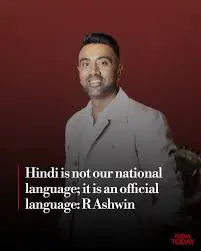The debate surrounding the status of Hindi as India’s national language has once again taken center stage, this time with Tamil Nadu BJP chief K. Annamalai lending his voice to the discourse. On Friday, Annamalai backed former cricketer Ravichandran Ashwin’s recent remark, emphasizing that Hindi is not the national language but merely an official language of India. His comments align with sentiments often expressed in Tamil Nadu, where language politics remain a deeply significant issue.
Ravichandran Ashwin Sparks a Conversation
During a convocation ceremony at a private college in Chennai, Ravichandran Ashwin engaged with the students on the subject of language preferences. When asked in what language he should address the audience, the cricketer’s query drew varied responses. While many opted for English, Tamil received overwhelming support, whereas Hindi garnered no response from the crowd.
Reflecting on this, Ashwin remarked, “Hindi is not our national language, but an official language.” The statement resonated strongly with his Tamil audience, reaffirming the state’s resistance to the idea of Hindi as a unifying language for the country.
Ashwin, who retired from international cricket during a Test series in Australia in December, is widely respected not only for his cricketing prowess but also for his articulate views on cultural and social matters. In his illustrious career, Ashwin played 106 Tests for India, taking 537 wickets at an average of 24.00, with best figures of 7/59. He also achieved 37 five-wicket hauls and eight ten-wicket match hauls, cementing his place as one of India’s greatest bowlers.
Annamalai Echoes Ashwin’s Sentiments
Following Ashwin’s remarks, BJP Tamil Nadu chief K. Annamalai voiced his agreement, reinforcing the idea that Hindi is not India’s national language. Speaking to ANI, Annamalai stated, “Correct. It is not our national language, which Annamalai is also telling you. Not only my dear friend Ashwin has to say that… It is not the national language. It was a link language, it is a language of convenience.”
Annamalai’s comments reflect a pragmatic stance on the language issue, highlighting the role of Hindi as a “link language” used for communication across linguistic boundaries rather than a cultural or national identifier. His perspective aligns with Tamil Nadu’s longstanding resistance to Hindi imposition, a sentiment deeply rooted in the state’s Dravidian political movements and cultural identity.
Historical Context: Tamil Nadu’s Resistance to Hindi Imposition
The opposition to Hindi imposition in Tamil Nadu dates back to the mid-20th century, when efforts to make Hindi the sole official language of India sparked protests in the state. The anti-Hindi agitations of the 1960s, led by Dravidian political parties, played a pivotal role in shaping Tamil Nadu’s linguistic and political landscape. The state’s leaders have consistently advocated for the preservation of regional languages and the recognition of India’s linguistic diversity.
Annamalai, despite being a member of the Bharatiya Janata Party—a party often associated with promoting Hindi—has reiterated his opposition to Hindi imposition. In 2022, he declared that the Tamil Nadu BJP would not support any attempts to enforce Hindi in the state. “The party’s definite stand is that Hindi imposition will not be allowed in Tamil Nadu,” he told reporters in Coimbatore.
Voluntary Learning vs. Imposition
Annamalai’s nuanced stance emphasizes the importance of choice when it comes to learning languages. “It is fine for people to learn Hindi voluntarily. I’m also learning Hindi voluntarily to be able to converse in Delhi,” he shared, revealing his personal efforts to bridge linguistic barriers. “I have an online tuition master to teach me. But if I’m instructed to study, even I won’t learn. Everyone is like that. So, the BJP will not allow Hindi being forced on anyone in Tamil Nadu,” he added.
This perspective underscores the importance of fostering linguistic harmony without compromising regional identities. By advocating for voluntary learning, Annamalai strikes a balance between practical communication needs and respect for cultural autonomy.
The Larger Debate on National Identity
The debate over Hindi as India’s national language is emblematic of a larger conversation about national identity and cultural pluralism. India’s linguistic diversity is one of its defining features, with the Constitution recognizing 22 scheduled languages. While Hindi and English serve as official languages for administrative purposes, no language holds the status of a “national language.”
Ashwin’s remarks and Annamalai’s endorsement reflect a broader resistance to homogenizing India’s cultural and linguistic landscape. For states like Tamil Nadu, preserving the primacy of Tamil is not just a matter of linguistic pride but also a way of safeguarding their unique cultural heritage.
Bridging Divides Through Dialogue
The comments by Ashwin and Annamalai open the door for constructive dialogue on how India can navigate its linguistic diversity. Instead of framing the debate as a binary conflict between Hindi and regional languages, the focus could shift toward fostering mutual respect and understanding among linguistic communities. Encouraging multilingualism and providing resources for learning multiple languages can serve as a bridge, uniting India’s diverse population without erasing its cultural distinctions.
Conclusion
Ravichandran Ashwin’s assertion that Hindi is an official language, not a national language, and K. Annamalai’s support for this view highlight the importance of acknowledging and respecting India’s linguistic diversity. In a country as vast and varied as India, no single language can encapsulate its essence. Instead, India’s strength lies in its ability to embrace its pluralism, allowing each language and culture to flourish.
As Tamil Nadu continues to champion its linguistic identity, voices like Ashwin and Annamalai’s remind us of the need for inclusivity and voluntary learning in fostering a truly united India. The dialogue around language is not just about communication—it’s about recognizing and celebrating the rich tapestry of identities that make up the nation.

